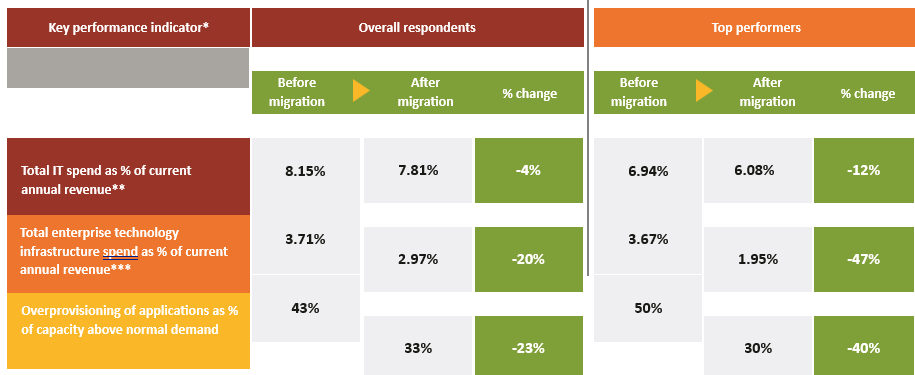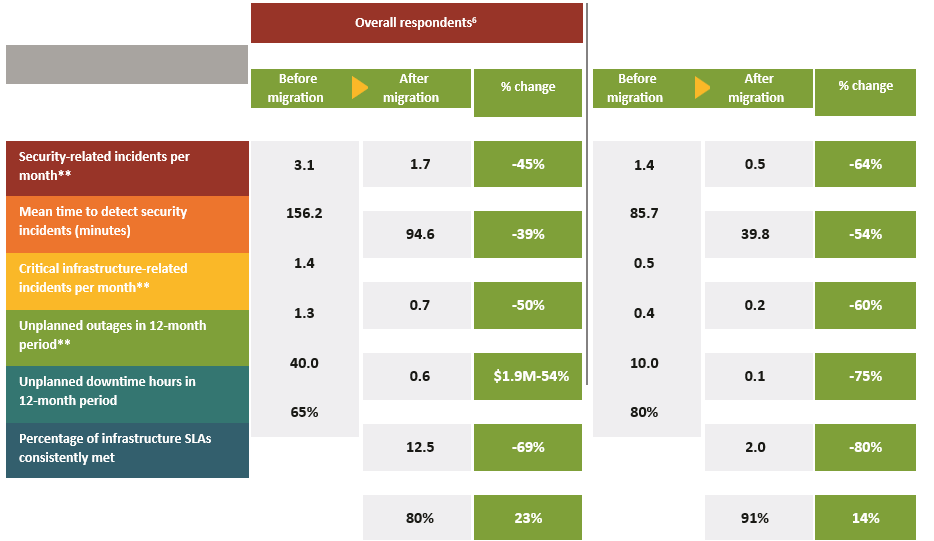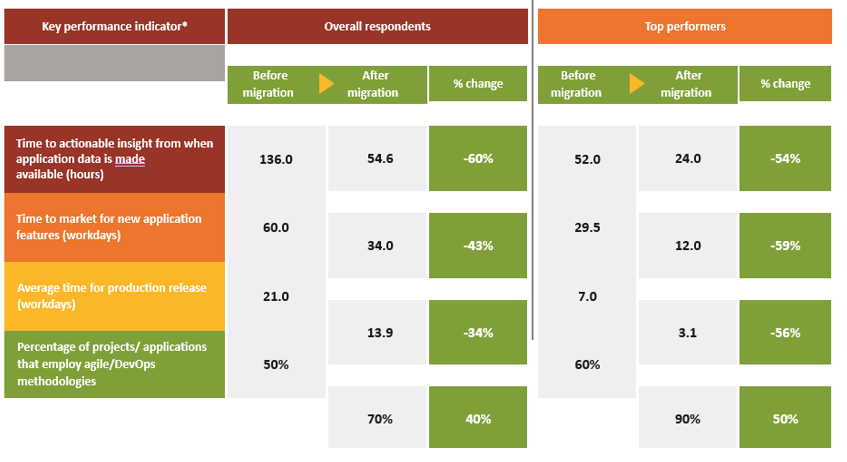AWS: Four Types of Cloud Business Value
In the era of digital transformation and infrastructure modernization, the journey to the cloud has been both exhilarating and challenging. Many businesses have successfully migrated their “easy” applications to the cloud. However, a prevailing concern lingers among business leaders—an uncertainty about the returns on investment in terms of time and effort. Questions arise about productivity gains, data security, and the impact on critical agility metrics, such as time to market.
Here, we delve into the distinct results observed by AWS users across four pivotal domains of cloud business worth: cost efficiency, workforce efficiency, resilience, and adaptability.
1. Cost Savings: More Than Meets the Eye
Migrating infrastructure to Amazon Web Services (AWS) yields significant cost savings, averaging around 20% in total infrastructure expenses. Top performers witness a staggering 47% reduction, highlighting the potential for substantial savings. Yet, the nuances lie in application-specific cost reductions that vary based on factors like application complexity and cloud tenure.
Studies reveal a significant financial shift for organizations venturing into AWS migration. On average, businesses witness a remarkable 20% reduction in total infrastructure costs—a noteworthy achievement translating to a staggering $69 million slashed from an average pre-migration annual IT spend of $345 million.
However, the journey to AWS doesn’t merely stop at these impressive numbers. For top performers, the stakes are higher, yielding an exceptional 47% savings in total infrastructure costs. This equates to a colossal $164 million reduction from an average annual IT spend of $349 million. (Refer to Fig. 1 for a graphical representation.)

Study participants also provided data for up to three specific applications transferred to AWS, allowing the calculation of cost savings specific to these applications. On average, infrastructure costs related to these applications witnessed a consistent decline of around 20% annually over a span of six years post-deployment.
Following migration, the extent of cost reductions varies among different application types. Multiple factors influence this variability, including the complexity of applications, their level of modernization and optimization before and after migration, and their duration within the cloud. Notably, patience yields rewards in this scenario. Analysis of application costs based on their tenure in AWS demonstrates an incremental improvement in savings rates with each passing year. (Refer to Fig. 2 for a graphical representation.)

Comparative analysis between cloud and on-premises deployments highlights a positive correlation between increased cloud adoption and various efficiency metrics.
Factors impacting potential cloud cost savings include baseline infrastructure costs, application types, duration in the cloud, and post-migration innovations. Organizations with high infrastructure spending can see a 41% reduction after migration compared to the 20% average. Additionally, AWS migration leads to a 23% cut in overprovisioned application capacity, optimizing efficiency and reducing unnecessary costs.
2. Workforce Efficiency
Following the migration of applications to AWS, there’s a noticeable enhancement in IT infrastructure staff productivity among respondents. They report a remarkable 66% rise in the number of retained VMs managed per administrator. Such post-migration efficiencies enable a strategic shift, allowing 17% of staff positions to transition from routine infrastructure maintenance to pivotal roles focusing on infrastructure planning, architecture, orchestration, and innovation (Refer to Fig. 3 for visual representation)

Moreover, a substantial productivity boost unfolds within development teams post-AWS migration. There’s a notable 29% increase in developer time dedicated to crafting new features and functionalities, shifting from minor updates handled by cloud providers. Leveraging AWS developer tools streamlines coding processes, further amplifying developer productivity. These enhancements result in a 32% average reduction in the time interval between production releases for migrated applications. This surge in productivity not only streamlines operations but also empowers organizations to overcome the barrier to innovation identified by respondents—the challenge of dedicating ample time to innovation amidst other pressing concerns.
A commercial finance organization exemplifies the tangible impact of AWS migration on innovation. Their technology division experienced a significant leap in developer focus post-migration. Initially allocating 20% of developer time to crafting new features, their shift to AWS elevated these efforts drastically. For customer relationship management and business intelligence, the focus surged to an impressive 60%, witnessing a threefold increase. However, the transformation was even more substantial for their migrated financial planning and analysis system, skyrocketing from a mere 20% pre-migration to a staggering 80% post-migration—showcasing an unparalleled fourfold increase.
3. Resilience
Cloud technology has redefined resilience by elevating system availability, reducing latency, and fortifying security measures. The disruptive impact of the pandemic accentuated the criticality of resilience, surpassing the effectiveness of traditional disaster recovery approaches and redundant data centers. Cloud-based infrastructure emerged as a crucial linchpin, ensuring uninterrupted operations during tumultuous times.
The scalability inherent in cloud services played a pivotal role during the pandemic, exceeding initial capacity plans by an astounding 90%. This scalability was instrumental in swiftly connecting and supporting remote workers, effectively mitigating disruptions. Chief Information Officers (CIOs) emphasized that their previous migration to AWS significantly facilitated the accommodation of sudden surges in demand, underscoring the importance of cloud infrastructure in maintaining seamless operations during critical periods.
A U.S.-based healthcare nonprofit’s strategic migration of its last on-premises ERP system to the cloud in 2019 fortuitously positioned it for the subsequent shutdowns and challenges brought on by the pandemic. The seamless integration of cloud technology enabled the organization to navigate and maintain operational continuity amidst adversity, highlighting the indispensable role of cloud solutions in supporting mission-critical functions and adapting to hybrid office-remote work models.
In today’s digital commerce landscape, system downtime carries profound consequences far beyond inconvenience. It significantly impacts businesses, directing customers towards competitors’ platforms. The financial implications of downtime are staggering, averaging 79 minutes and costing approximately $84,650 per hour in 2020. Furthermore, the aftermath of data breaches and ransomware attacks extends beyond financial costs, causing public embarrassment and substantial recovery expenses, averaging $4.6 million for cyberattacks and $4.2 million for data breaches.
The migration to AWS represents a transformative milestone, significantly bolstering both availability and security. Many key resilience Key Performance Indicators (KPIs) exceeded the 50% mark, as illustrated in Fig. 4. This substantial enhancement underscores the transformative impact of AWS migration in fortifying operational resilience and proactively mitigating potential threats.

4. Adaptability
The most strategic of all cloud migration benefits, agility equips organizations for success in a digital business environment. Agility refers to the ability to respond quickly and effectively to changes in business conditions or disruptive business events. Broadly speaking, the more technology infrastructure an organization has in the cloud, the more agile it can be. A study by The Hackett Group on agility in business services functions (i.e., finance, HR, IT, and procurement), found that the most agile organizations have 41% of their infrastructure in the cloud, compared to just 29% for the average respondent.
Winning in a digitally competitive industry or market depends heavily on agility in product development. A major aspect is the speed at which new technology-enabled products and features are brought to market. For applications in the cloud, technology organizations are better able to use agile/DevOps methodologies thanks to services that simplify and accelerate provisioning infrastructure, deploying application code, automating software release processes, and monitoring application and infrastructure performance. These changes, combined with the development-team productivity gains discussed earlier, contribute to a 43% decrease in time to market and a faster pace for production releases (Fig. 5).

Recommendations
The Cloud Services Study underscores how migrating to AWS drives substantial business value across cost savings, staff productivity, resiliency, and agility. It dispels the notion that the cloud is solely a cost-saving venture, highlighting its strategic superiority over traditional on-premises infrastructure. The agility alone—enabling quicker time to market, enhanced insights, and frequent production releases—positions organizations competitively in the digital sphere. This transformative shift from infrastructure management to innovative development is a pivotal game-changer.
In forthcoming reports, we’ll delve deeper into specific migration strategies and cloud financial management practices that contribute to superior outcomes. Meanwhile, here are key insights from this study:




